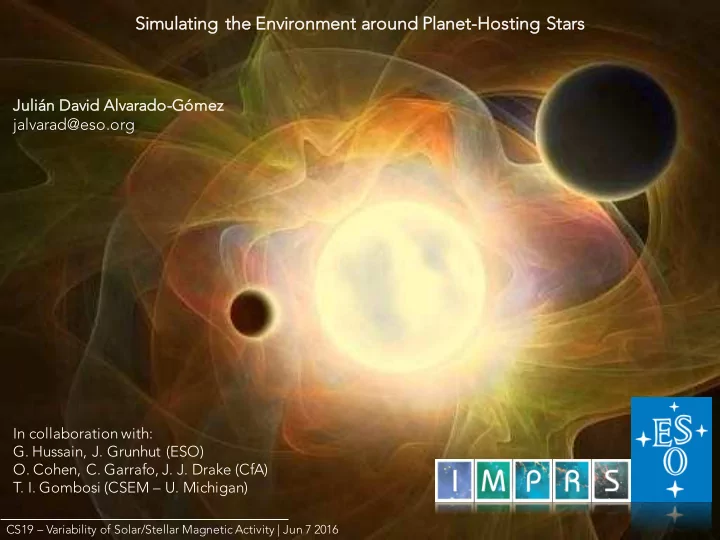

Si Simul ulating ng the he Env nvironm nment ent aro round und Pl Planet-Ho Hosti ting g St Stars Ju Julián David Alvarado-Gó Gómez jalvarad@eso.org In collaboration with: G. Hussain, J. Grunhut (ESO) O. Cohen, C. Garrafo, J. J. Drake (CfA) T. I. Gombosi (CSEM – U. Michigan) CS19 – Variability of Solar/Stellar Magnetic Activity | Jun 7 2016
Mo Motivation: Un Understand the effects of stellar magnetic fields on the su surrounding environment High-Energy Emission Coronal Structure + Stellar Wind + Planetary Environment Transient Phenomena (Flares/CMEs) Astrospheres Advanced Observational Techniques Detailed Numerical Simulations 2 Julián David Alvarado-Gómez | CS19 – Variability of Solar/Stellar Magnetic Activity
Observations This Study: Targets: Moderately active, planet–hosting Sun–like stars Data: High–Resolution spectropolarimetric time-series from HARPSpol@ESO3.6m Technique: Zeeman-Doppler Imaging (ZDI) Result: Surface distribution of the large–scale magnetic field Name Na Spec Sp ectral T EF R ★ M ★ P RO Activity Ac M p si sin(i) a EFF ROT Type Ty [K [K] [R ¤ ] [R [M ¤ ] [M [d [d] lo log(R’ HK HK ) log(L X ) lo [M [M � ] [A [AU] HD 1237 G8V 5572 0.86 1.00 7.00 – 4.38 29.02 3.37 0.49 HD 22049 K2V 5146 0.74 0.86 11.68 – 4.47 28.22 1.55 3.39 HD 147513 G5V 5930 0.98 1.07 10.00 – 4.64 28.92 1.21 1.32 Target systems astrophysical properties. References: HD1237 (GJ 3021): Naef et al. (2001) HD 22049 ( ε Eridani) : Drake & Smith (1993), Hatzes et al. (2000), Benedict et al. (2006) HD 147513 (62 G Scorpii): Mayor et al. (2004) 3 Julián David Alvarado-Gómez | CS19 – Variability of Solar/Stellar Magnetic Activity
HD 1237 (GJ 3021) (Alvarado–Gómez et al. 2015) HD 22049 ( ε Eridani) (Piskunov et al. 2011, Jeffers et al. 2014) HD 147513 (62 G Scorpii) (Hussain et al. 2016) 4 Julián David Alvarado-Gómez | CS19 – Variability of Solar/Stellar Magnetic Activity
Data-driven numerical simulations Space Weather Modeling Framework (SWMF) State-of-the-art 3D MHD code used and validated in different Heliophysics domains High-performance / parallel computing Physics-based space weather simulations: Self-consistently calculated: Coronal heating / stellar wind acceleration (Alfven wave turbulence dissipation + radiative cooling + electron heat conduction…) Input: Surface magnetic field maps (e.g. CR Maps / ZDI maps) Model: Coronae, Winds, Circumstellar Environment, Star-planet interactions… Solar Minimum Solar Maximum 5 (van der Holst et al. 2014) Julián David Alvarado-Gómez | CS19 – Variability of Solar/Stellar Magnetic Activity
3D Coronal Structure Coronal features: Field topology Coronal thermodynamic conditions: Field strength (Unsigned flux) HD 1237 ε Eridani HD 147513 Emission Measure (EM) Distribution DENSITY TEMPERATURE SXR EMISSION Synthetic Spectra (Alvarado–Gómez et al. 2016a) 6 Julián David Alvarado-Gómez | CS19 – Variability of Solar/Stellar Magnetic Activity
Solar Wind Structure Solar Minimum Solar Maximum Alvarado–Gómez et al. (2016b, submitted) Fast-wind from the poles Slow-wind dominates the structure (Coronal Holes) (closed-field regions) Slow-wind along the Equatorial plane Almost no fast wind regions (“Ballerina Skirt”) Increased complexity 7 Julián David Alvarado-Gómez | CS19 – Variability of Solar/Stellar Magnetic Activity
Stellar Wind Structure HD 22049 ( ε Eridani) HD 147513 (62 G Scorpii) Alvarado–Gómez et al. (2016b, submitted) Mass loss: ~1 – 5 M ¤ ~6 M ¤ Angular momentum loss: ~1 – 12 J ¤ ~ 4 J ¤ 8 Julián David Alvarado-Gómez | CS19 – Variability of Solar/Stellar Magnetic Activity
Alvarado–Gómez et al. (2016b, submitted) HD 1237 (GJ 3021) Jupiter–mass planet located at ~ 0.5 AU (P ORB = 133.7 ± 0.2 days, e = 0.49) (Naef et al. 2001) Strong wind-planet interactions along the orbit Potentially detectable in Radio (F R ~ 12 mJy) ~3 – 7 M ¤ Mass loss: Angular ~7 – 60 J ¤ momentum loss: 9 Julián David Alvarado-Gómez | CS19 – Variability of Solar/Stellar Magnetic Activity
Stellar winds and Habitable Zones (HZ) Inner HZs boundaries taken from the Habitable Zone Gallery (http://www.hzgallery.org/ - Kane & Gelino 2012) MHD Characterization of the 3D structure of the stellar wind. Dynamical determination of the HZ inner boundary Stellar wind properties • Host-star activity level • Planetary magnetospheric shielding • Alvarado–Gómez et al. (2016b, submitted) 10 Julián David Alvarado-Gómez | CS19 – Variability of Solar/Stellar Magnetic Activity
Poster 59 11 Julián David Alvarado-Gómez | CS19 – Variability of Solar/Stellar Magnetic Activity
12
MDI/SOHO Synoptic Magnetograms (Carrington Maps) 13 Julián David Alvarado-Gómez | CS19 – Variability of Solar/Stellar Magnetic Activity
Ob Observations: Hi High-Re Resolution Sp Spec ectropolarimet etry NARVAL@TBL ESPaDOnS@CFHT HARPSpol@ESO-3.6m D = 2 m | R ~ 65000 D = 3.6 m | R ~ 70000 D = 3.6 m | R ~ 120000 λ ~ 370 – 1050 nm λ ~ 370 – 1050 nm λ ~ 378 – 691 nm Fut Futur ure e ins nstrum ument ents/up upgrades es: RV precision < 3 m/s R ~ 75000 | λ ~ 0.98 – 2.35 µm First Light: ~ 2018 RV precision ~ 1 m/s First Light: ~ 2017 14 Julián David Alvarado-Gómez | CS19 – Variability of Solar/Stellar Magnetic Activity
Rotational modulation of the high-energy emission (Alvarado–Gómez et al. 2016a) 15 Julián David Alvarado-Gómez | CS19 – Variability of Solar/Stellar Magnetic Activity
Astrospheres: Mass loss – Activity Relation Mass loss rates estimates only for 10 Sun - like (G-K type) stars Apparent correlation between mass loss and x-ray activity (Physical Units!) Open questions: 2 regimes? ( π 1 UMa) – Models in the high activity end? – Binarity? Solar-like GK main sequence stars M dwarfs 16 Julián David Alvarado-Gómez | CS19 – Variability of Solar/Stellar Magnetic Activity
Recommend
More recommend